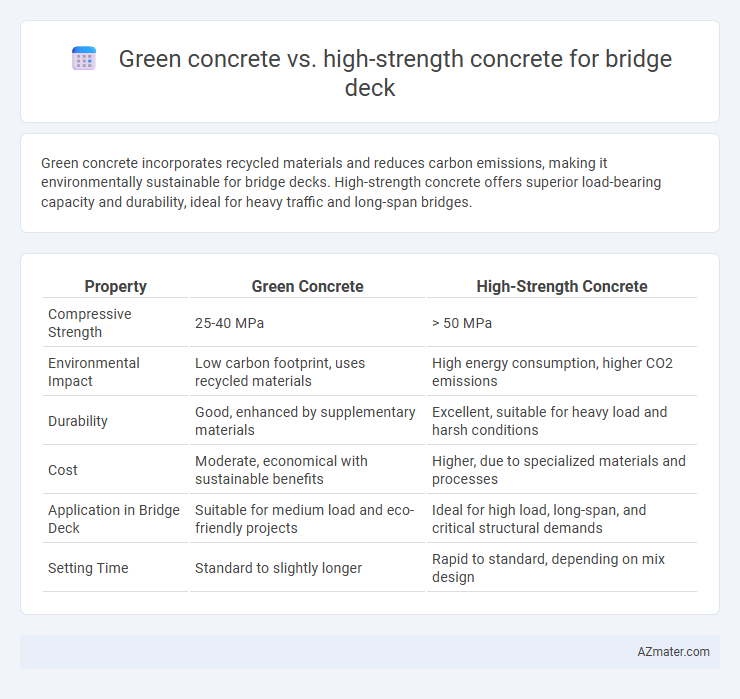Green concrete incorporates recycled materials and reduces carbon emissions, making it environmentally sustainable for bridge decks. High-strength concrete offers superior load-bearing capacity and durability, ideal for heavy traffic and long-span bridges.
Table of Comparison
| Property | Green Concrete | High-Strength Concrete |
|---|---|---|
| Compressive Strength | 25-40 MPa | > 50 MPa |
| Environmental Impact | Low carbon footprint, uses recycled materials | High energy consumption, higher CO2 emissions |
| Durability | Good, enhanced by supplementary materials | Excellent, suitable for heavy load and harsh conditions |
| Cost | Moderate, economical with sustainable benefits | Higher, due to specialized materials and processes |
| Application in Bridge Deck | Suitable for medium load and eco-friendly projects | Ideal for high load, long-span, and critical structural demands |
| Setting Time | Standard to slightly longer | Rapid to standard, depending on mix design |
Introduction to Bridge Deck Materials
Bridge decks require materials with excellent durability and load-bearing capacity to withstand heavy traffic and environmental stress. Green concrete, made with recycled materials and industrial byproducts, offers sustainable benefits by reducing carbon footprint and conserving natural resources. High-strength concrete, characterized by compressive strengths exceeding 6,000 psi, provides superior performance in terms of structural integrity and longevity for bridge deck applications.
Overview of Green Concrete
Green concrete for bridge decks incorporates recycled materials and industrial by-products such as fly ash, slag, and silica fume to reduce carbon footprint and enhance sustainability. Its composition improves durability and resistance to chemical attacks while maintaining adequate strength for structural applications. The eco-friendly nature of green concrete aligns with environmental regulations and enables cost-effective construction by utilizing locally sourced materials.
Overview of High-Strength Concrete
High-strength concrete (HSC) used for bridge decks is characterized by compressive strengths typically above 6,000 psi, providing superior load-bearing capacity and enhanced durability compared to conventional concrete. Its dense microstructure minimizes permeability, reducing susceptibility to chloride intrusion and corrosion of reinforcement, which is critical in harsh bridge environments. The use of HSC allows for slimmer deck profiles, leading to lighter structures and longer span capabilities while maintaining structural integrity and safety.
Environmental Impact Comparison
Green concrete for bridge decks significantly reduces carbon emissions by incorporating industrial by-products like fly ash or slag, lowering cement content and promoting sustainability. High-strength concrete, while offering superior load-bearing capacity, involves higher cement consumption, increasing its environmental footprint due to elevated CO2 emissions. Selecting green concrete supports eco-friendly infrastructure development by balancing durability with reduced environmental impact in bridge construction projects.
Mechanical Performance and Durability
Green concrete for bridge decks offers excellent mechanical performance with moderate compressive strength, enhanced by supplementary cementitious materials that improve sustainability and reduce carbon footprint. High-strength concrete exhibits superior compressive strength and stiffness, making it ideal for heavy load-bearing applications but may suffer from reduced durability in aggressive environments due to higher brittleness and shrinkage. Durability of green concrete is often enhanced through lower permeability and improved resistance to chemical attacks, while high-strength concrete requires careful mix design and curing to mitigate cracking and ensure long-term performance under cyclic loading and environmental stressors.
Cost Analysis and Economic Considerations
Green concrete reduces material expenses by incorporating industrial by-products like fly ash and slag, lowering cement usage and overall raw material costs for bridge decks. High-strength concrete demands higher-grade cement and additives, increasing initial costs despite providing enhanced durability and load-bearing capacity. Economic evaluations favor green concrete for sustainable projects with budget constraints, while high-strength concrete suits applications prioritizing long-term performance and reduced maintenance expenditures.
Construction Practices and Workability
Green concrete offers enhanced workability due to the incorporation of supplementary cementitious materials like fly ash and slag, which improve consistency and reduce water demand in bridge deck construction. High-strength concrete requires precise mixing and placement techniques to ensure uniformity and avoid segregation, often demanding skilled labor and advanced formwork systems. Construction practices for green concrete emphasize sustainability and reduced carbon footprint, while high-strength concrete focuses on achieving maximum structural performance under heavy loads.
Long-Term Maintenance and Lifecycle
Green concrete, composed of recycled materials and industrial by-products, offers reduced environmental impact and enhanced durability, leading to lower long-term maintenance costs for bridge decks. High-strength concrete, with its superior compressive strength above 6000 psi, provides exceptional load-bearing capacity but may require more frequent inspections and repairs due to potential brittleness over time. Lifecycle assessments indicate that green concrete's sustainability benefits combined with adequate performance reduce overall lifecycle expenses compared to the higher initial costs and maintenance demands of high-strength concrete in bridge deck applications.
Suitability for Various Bridge Deck Applications
Green concrete, incorporating recycled materials and reduced cement content, offers enhanced environmental benefits and adequate durability for low to medium traffic bridge decks with moderate load requirements. High-strength concrete, characterized by its superior compressive strength (typically exceeding 6000 psi), is ideal for heavy-load, long-span bridge decks demanding exceptional structural performance and reduced member size. Suitability depends on project specifications; green concrete excels in sustainability-focused projects, while high-strength concrete ensures safety and longevity in critical infrastructure applications.
Future Trends and Innovations in Concrete Technology
Green concrete integrates sustainable materials like recycled aggregates and industrial by-products, reducing carbon footprint while enhancing durability for bridge decks. High-strength concrete continues to evolve with advanced admixtures and nanomaterials, achieving superior compressive strength and faster curing times critical for long-span bridges. Emerging innovations such as self-healing concrete and carbon dioxide sequestration techniques are reshaping bridge construction by improving longevity and environmental impact.

Infographic: Green concrete vs High-strength concrete for Bridge deck
 azmater.com
azmater.com